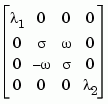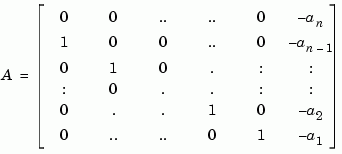

| Function Reference |   |
Compute canonical state-space realizations
Syntax
Description
canon computes a canonical state-space model for the continuous or discrete LTI system sys. Two types of canonical forms are supported.
Modal Form
csys = canon(sys,'type') returns a realization csys in modal form, that is, where the real eigenvalues appear on the diagonal of the  matrix and the complex conjugate eigenvalues appear in 2-by-2 blocks on the diagonal of
matrix and the complex conjugate eigenvalues appear in 2-by-2 blocks on the diagonal of  . For a system with eigenvalues
. For a system with eigenvalues  , the modal
, the modal  matrix is of the form
matrix is of the form

Companion Form
csys = canon(sys,'type') produces a companion realization of sys where the characteristic polynomial of the system appears explicitly in the rightmost column of the  matrix. For a system with characteristic polynomial
matrix. For a system with characteristic polynomial

the corresponding companion  matrix is
matrix is

also returns the state coordinate transformation T relating the original state vector  and the canonical state vector
and the canonical state vector  .
.

This syntax returns T=[] when sys is not a state-space model.
Algorithm
Transfer functions or zero-pole-gain models are first converted to state space using ss.
The transformation to modal form uses the matrix  of eigenvectors of the
of eigenvectors of the  matrix. The modal form is then obtained as
matrix. The modal form is then obtained as

The state transformation  returned is the inverse of
returned is the inverse of  .
.
The reduction to companion form uses a state similarity transformation based on the controllability matrix [1].
Limitations
The modal transformation requires that the  matrix be diagonalizable. A sufficient condition for diagonalizability is that
matrix be diagonalizable. A sufficient condition for diagonalizability is that  has no repeated eigenvalues.
has no repeated eigenvalues.
The companion transformation requires that the system be controllable from the first input. The companion form is often poorly conditioned for most state-space computations; avoid using it when possible.
See Also
ctrb Controllability matrix
ctrbf Controllability canonical form
ss2ss State similarity transformation
References
[1] Kailath, T. Linear Systems, Prentice-Hall, 1980.
 | c2d | care |  |